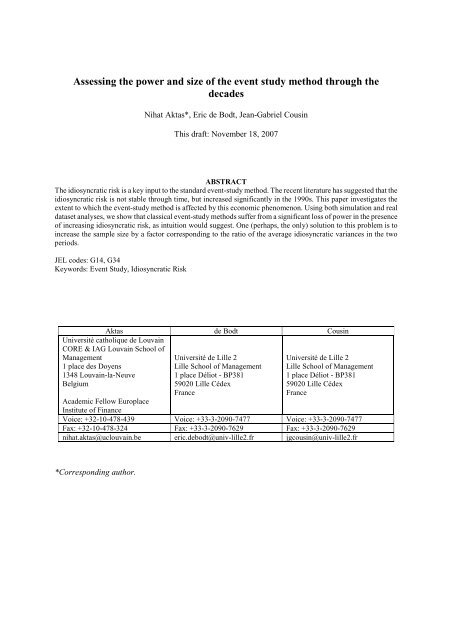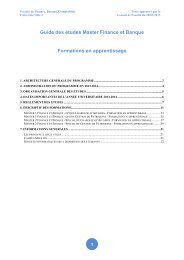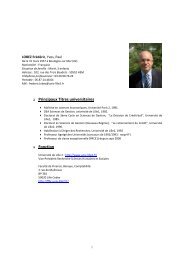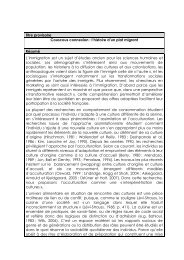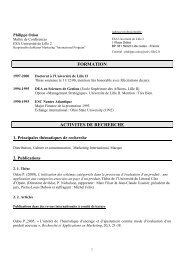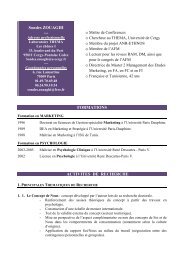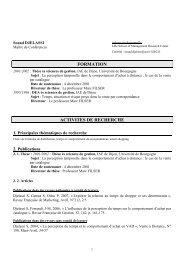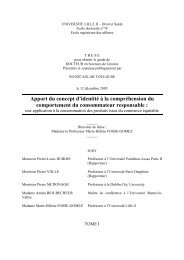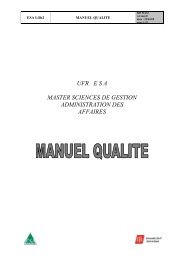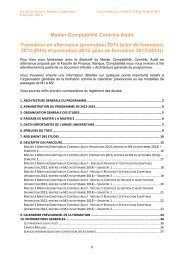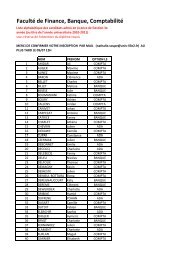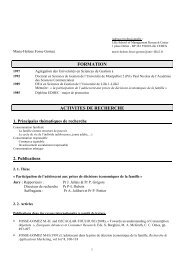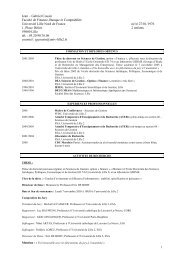Event Study
Event Study
Event Study
Create successful ePaper yourself
Turn your PDF publications into a flip-book with our unique Google optimized e-Paper software.
Assessing the power and size of the event study method through the<br />
decades<br />
Nihat Aktas*, Eric de Bodt, Jean-Gabriel Cousin<br />
This draft: November 18, 2007<br />
ABSTRACT<br />
The idiosyncratic risk is a key input to the standard event-study method. The recent literature has suggested that the<br />
idiosyncratic risk is not stable through time, but increased significantly in the 1990s. This paper investigates the<br />
extent to which the event-study method is affected by this economic phenomenon. Using both simulation and real<br />
dataset analyses, we show that classical event-study methods suffer from a significant loss of power in the presence<br />
of increasing idiosyncratic risk, as intuition would suggest. One (perhaps, the only) solution to this problem is to<br />
increase the sample size by a factor corresponding to the ratio of the average idiosyncratic variances in the two<br />
periods.<br />
JEL codes: G14, G34<br />
Keywords: <strong>Event</strong> <strong>Study</strong>, Idiosyncratic Risk<br />
Aktas de Bodt Cousin<br />
Université catholique de Louvain<br />
CORE & IAG Louvain School of<br />
Management<br />
1 place des Doyens<br />
1348 Louvain-la-Neuve<br />
Belgium<br />
Université de Lille 2<br />
Lille School of Management<br />
1 place Déliot - BP381<br />
59020 Lille Cédex<br />
France<br />
Université de Lille 2<br />
Lille School of Management<br />
1 place Déliot - BP381<br />
59020 Lille Cédex<br />
France<br />
Academic Fellow Europlace<br />
Institute of Finance<br />
Voice: +32-10-478-439 Voice: +33-3-2090-7477 Voice: +33-3-2090-7477<br />
Fax: +32-10-478-324 Fax: +33-3-2090-7629 Fax: +33-3-2090-7629<br />
nihat.aktas@uclouvain.be eric.debodt@univ-lille2.fr jgcousin@univ-lille2.fr<br />
*Corresponding author.
Fama, Fisher, Jensen and Roll (1969) (referred to below as FFJR) established the foundations of the<br />
(short-term) event-study method, which has become a main tool for empirical research in finance and<br />
accounting. From a method to test the efficient-market hypothesis, to a valuation tool to measure the<br />
wealth effects of corporate events (assuming market efficiency), countless applications have been<br />
published. According to Kothari and Warner (2007), between 1974 and 2000, some 565 papers in<br />
leading finance journals contained an event study 1 .<br />
From a methodological point of view, the literature includes many proposed improvements to the standard<br />
event-study method. Without being exhaustive, the main methodological contributions are the following:<br />
Brown and Warner (1980; 1985) assessed the specification and power of several modifications of the<br />
FFJR approach; Malatesta and Thompson (1985) proposed a model to deal with partially anticipated<br />
events; Ball and Torous (1988) explicitly took into account the uncertainty about event dates; Corrado<br />
(1989) and Cowan (1992) introduced a non-parametric test of significance. Boehmer et al. (1991)<br />
proposed an adaptation of the standard methodology to tackle an event-induced increase in return<br />
volatility; Salinger (1992) suggested an adjustment of the abnormal returns standard errors robust to event<br />
clustering; Savickas (2003) recommended the use of a GARCH specification to control for the effect of<br />
time-varying conditional volatility; Aktas et al. (2004) advocated the use of a bootstrap method as an<br />
alternative to Salinger’s (1992) proposition; Harrington and Shrider (2007) argued that all events induce<br />
variance, and therefore tests robust to cross-sectional variance change should always be used; and<br />
recently, Aktas et al. (2007) proposed a two-state market-model approach to tackle estimation window<br />
contamination.<br />
However, in general, as stressed by Kothari and Warner (2007), the key feature of the event study<br />
approach is its robustness to specific methodological choices (the return-generating model, the statistical<br />
1 The journals surveyed were Journal of Business, Journal of Finance, Journal of Financial Economics, Journal of<br />
Financial and Quantitative Analysis and Review of Financial Studies. Survey and methodological papers are<br />
excluded from the count. Since many academic and practitioner-oriented journals were excluded, the reported figure<br />
provides a lower bound on the size of the event-study literature.<br />
2
test, the length of the estimation and event windows etc.). Thus, except for its reliance on market<br />
efficiency, the event study method appears not to suffer from serious criticisms.<br />
One of the key inputs in calculating the test statistic in an event study is the individual firm (abnormal)<br />
return variance or standard deviation. With respect to this important variable, Kothari and Warner (2007)<br />
report that the mean daily standard deviation for all CRSP listed firms is 0.053 from 1990 to 2002. This is<br />
higher than the value of 0.026 reported by Brown and Warner (1985). Consistent with Campbell et al.’s<br />
(2001) finding, this result implies that individual stocks have become more volatile over time 2 , suggesting<br />
that ‘the power to detect abnormal performance for events over 1990−2002 is lower than for earlier<br />
periods’ (Kothari and Warner, 2007, p. 16). Campbell et al. (2001) also recognised that the increase in the<br />
idiosyncratic volatility might potentially affect the event study analysis. In particular, the authors<br />
emphasise that ‘firm-level volatility is important in event studies. <strong>Event</strong>s affect individual stocks, and the<br />
statistical significance of abnormal event-related returns is determined by the volatility of individual stock<br />
returns relative to the market or industry’ (Campbell et al., 2001, p. 2).<br />
Comparisons of event-study results obtained during different time periods are quite frequent in the<br />
academic literature. As an illustration, we take the case of European mergers and acquisitions (M&A) and<br />
report the results of an event study realized by Goergen and Renneboog (2004). In their Table 11, the<br />
authors provide bidders’ average CARs for the time periods before and after 1999. Before 1999, for a<br />
sample of 74 bidders, the average CAR over the event window [−2,+2] was 1.22% with a t-statistic of<br />
2.98. After 1999, for a sample size of 68 firms, the corresponding average CAR was 1.14% with a t-<br />
statistic of 1.80. Despite the similar CAR levels and sample sizes in the two periods, the statistical<br />
significance is lower in the more recent period. The associated t-statistic is divided by a factor of 1.66.<br />
The loss of power is most likely due to an increase in the idiosyncratic volatility between the two periods.<br />
2 Investigating the period between 1962 and 1997, Campbell et al. (2001) showed that the idiosyncratic risk<br />
increased over time. This result is robust to the model chosen to estimate the idiosyncratic variance, and<br />
economically significant with the firm-level idiosyncratic volatility more than doubling during the period being<br />
analysed.<br />
3
We propose to explore this issue in this paper. More precisely, we investigate whether, and to what extent,<br />
the increase in individual firm’s idiosyncratic volatility affects the power and specification of event<br />
studies. The question is important. If the power and specification of the tests are not stable through time<br />
and/or across geographical zones, it means that comparisons of results obtained from different time<br />
periods and/or geographical zones are potentially biased 3 . It would be like trying to compare the size of<br />
objects using a time varying measurement tool!<br />
We rely on both simulation and real data set analyses. First, we realize a simulation analysis following the<br />
procedure introduced by Brown and Warner (1980. 1985), in which our sample encompasses companies<br />
included in the CRSP daily returns file from 1 January 1976 to 31 December 2004. We simulate both<br />
deterministic and stochastic abnormal returns on the event date. Then, we perform event study analyses on<br />
a real data set of corporate events to check whether the significance tests are affected by a change in<br />
idiosyncratic volatility. The chosen event is a merger and acquisition (M&A) announcement. Our M&A<br />
sample contains 5,401 deals realized by US companies between 1980 and 2004. Our main results are:<br />
― While the specification of the event study is robust to the variation of the idiosyncratic volatility,<br />
we clearly confirm, as expected, a time-variation in the power over the long run. We provide<br />
evidence spanning the period 1976 to 2004 and using the main US stock markets (NYSE, Amex<br />
and Nasdaq). The effect appears to be significant. For example, using the market model and<br />
Boehmer et al.’s (1991) statistical test procedure on a sample of 50 firms, 1% simulated abnormal<br />
returns (with event-induced variance) are detected 74% of the time during the period 1976−1980,<br />
but only 51% of the time during the period 1996−2000.<br />
― We also show that the use of different return-generating models (the constant mean-return model,<br />
the beta-one model and the market model) and/or different statistical test procedures (Brown and<br />
3 Guo and Savickas (in press) show that the level of the average idiosyncratic volatility is different across<br />
geographical zones. For example, over the period 1973 to 2003, the average idiosyncratic volatilities in the UK and<br />
France are less than the half of that in the US.<br />
4
Warner (1980), Boehmer et al. (1991) and the rank test suggested by Corrado (1989)) does not<br />
help to resolve the issue.<br />
― We then confirm these conclusions using a sample of M&A announcements. For example, the<br />
Boehmer et al. (1991) event study approach is far less powerful when the environment is<br />
characterized by a high level of idiosyncratic volatility. The power of the test goes from 98.30%<br />
in 1980-1990 to 21.90% in 1991-2000, with the latter period being the one with the highest level<br />
of idiosyncratic volatility.<br />
― We finally conclude that a practical solution is to increase the sample size to compensate for the<br />
increase in idiosyncratic volatility. To keep the power of the event study constant, a simple rule<br />
of thumb is to increase the sample size by a factor corresponding to the ratio of the average<br />
idiosyncratic variances in the periods being analysed. We provide a two-entry table to facilitate<br />
inter-temporal comparison of event-study results within the US. Using the results provided by<br />
Guo and Savickas (in press), we also present a two-entry table for comparisons of international<br />
event-study results.<br />
This paper is organised in four sections. In Section 1, we show that we must indeed expect that the power<br />
of event studies will be affected by the level of idiosyncratic volatility. Section 2 introduces the research<br />
design. Section 3 is devoted to the presentation of our empirical results based on simulation and real<br />
dataset analyses. The final section summarises our work and presents our conclusions.<br />
1. Econometric arguments<br />
An elegant framework to explore the effects of an increase in firm-level idiosyncratic volatility on the<br />
power and specification of the event-study approach is the dummy-variable regression model introduced<br />
by Karafiath (1988):<br />
R i,<br />
t α i + βi<br />
Rm,<br />
t + γ iDi<br />
, t + ε i,<br />
t<br />
= , (1)<br />
5
where Ri,t and Rm,t are the returns of firm i and of a market-portfolio proxy at time t, respectively. We<br />
identify the event dates using a dummy variable, denoted Di,t, which takes the value 1 for days in the<br />
event window and 0 otherwise. The coefficient of interest, γi, is an estimate of the firm i’s average<br />
abnormal return over the event window (AARi,E).<br />
Under the classical assumptions of identically and independently distributed disturbances εi,t, the standard<br />
regression results provide us with the standard errors of AARi,E:<br />
−1<br />
2<br />
( [ X ' X ] ) σ ( ε )<br />
2<br />
σ ( γ ) = , (2)<br />
i<br />
2,<br />
2<br />
i<br />
where [X'X] −1 corresponds to the inverse of the variance-covariance matrix of the independent variables<br />
and (.)2,2 is the element of the matrix between parentheses located at Row 2 and Column 2. σ 2 (εi) is a<br />
measure of the firm i’s idiosyncratic risk 4 . The effect of an increase in idiosyncratic risk on the variance of<br />
AARi,E is therefore given by:<br />
2<br />
σ ( γ i )<br />
= 2<br />
∂σ<br />
( ε )<br />
1 ( [ X ' X ] ) > 0<br />
∂ −<br />
i<br />
2,<br />
2<br />
. (3)<br />
Equation (3) is strictly positive (it is a variance), which shows that an increase in the idiosyncratic<br />
variance increases the variance of AARi,E. Consequently, this reduces the significance of the coefficient γi.<br />
Therefore, Equation (3) clearly indicates a loss of power due to an increase in a firm’s idiosyncratic risk ,<br />
in a case-study analysis.<br />
For a sample study, we need to compute a statistical test of significance for the cross-sectional average<br />
cumulative abnormal return (ACAR). A convenient candidate is the classical Brown and Warner (1980)<br />
test of significance. Using N to denote the sample size and TE for the length of the event window, the<br />
statistical test of significance for ACAR is given by the Student t-statistic<br />
4 Note that this measure is different from that used by Campbell et al. (2001). These authors introduced a model-free<br />
measure of idiosyncratic risk into their study to avoid the risk of their results being dependent on a specific model.<br />
6
t<br />
ACAR<br />
N<br />
N<br />
1<br />
2 1 2⎛<br />
⎞<br />
= ∑TEγ<br />
i TE<br />
σ ⎜∑<br />
γ i ⎟ . (4)<br />
2<br />
N i=<br />
1<br />
N ⎝ i=<br />
1 ⎠<br />
Using basic algebra to simplify Equation (4), and assuming cross-sectionally uncorrelated cumulative<br />
abnormal returns, the Student t-statistic for the ACAR becomes<br />
where<br />
N<br />
∑<br />
i=<br />
1<br />
γ i<br />
1<br />
t ACAR = , (5)<br />
N σ<br />
2<br />
γ<br />
2<br />
σ γ is the cross-sectional average of the abnormal return variance. Since an increase in<br />
idiosyncratic variance leads to an increase in σ 2 2<br />
(γi), σ γ also increases as the idiosyncratic variance<br />
increases.<br />
Using Equation (5), it is straightforward to show that:<br />
― for value-creating events (positive average abnormal returns), the relation between tACAR and σ<br />
is negative. An increase in firm-level idiosyncratic risk leads to a decrease in the (positive)<br />
Student t-statistic.<br />
― for value-destroying events (negative average abnormal returns), the relation between tACAR and<br />
2<br />
σ γ is positive. An increase in firm-level idiosyncratic risk leads to an increase in the (negative)<br />
Student t-statistic.<br />
To sum-up, we can expect the power of the event-study test to be a decreasing function of the individual<br />
firm’s idiosyncratic risk. We now turn to a systematic exploration of the relationship between<br />
idiosyncratic volatility and event-study power and size, using simulation and real data analyses.<br />
7<br />
2<br />
γ
2. Research design<br />
2.1. Return-generating processes and statistical tests<br />
The abnormal return, ARi,t, corresponds to the forecast errors of a specific normal return-generating model<br />
(in Section 1, to simplify the exposition, we described them as the coefficient estimates of a dummy<br />
variable). In other words, the abnormal return is the difference between the return conditional on the event<br />
and the expected return unconditional on the event. To study the extent to which variations in the<br />
idiosyncratic risk affect the power and size of the event study methods, we used three normal return-<br />
generating processes and three statistical tests. The set of approaches was chosen because they had been<br />
used in classical methodological studies (e.g., Brown and Warner 1980; 1985; Boehmer et al. 1991).<br />
The models of normal returns we considered are the market model (MM), the beta-one model (BETA-1)<br />
and the constant mean return model (CMRM). We selected the MM because it is by far the most<br />
frequently-used model in the literature. The BETA-one model has recently been employed in several<br />
large-scale empirical studies of M&As (Fuller et al. 2002; Moeller et al. 2004; 2005) to avoid using data<br />
from an estimation window which itself contains other M&A deal announcements. We selected the<br />
CMRM because its simplicity might indicate some robustness to a noisy environment. Using the same<br />
notation as in Section 1 (the hat and the bar symbols are used to denote, respectively, coefficient estimates<br />
and sample averages from estimation-window data), we compute the abnormal return for stock i at time t<br />
using the three equations:<br />
(MM) AR = R − ˆ α + ˆ β R ) ; (6)<br />
i,<br />
t i,<br />
t ( i i m,<br />
t<br />
(BETA-1) i t = Ri<br />
t − Rm<br />
t ; (7)<br />
AR , , ,<br />
(CMRM) ARi, t = Ri,<br />
t − Ri<br />
. (8)<br />
We used three statistical tests: the Brown and Warner (1980) test (BW), the Boehmer et al. (1991) test<br />
(BMP), and the Corrado (1989) rank test (RANK). These are probably the tests most regularly used in the<br />
8
academic literature. Let us denote by N the number of firms in the dataset, by T the number of days in the<br />
estimation window, by E the event date, by σi the standard deviation of firm i’s abnormal returns during<br />
the estimation window, and by Rm,t the market return for day t. The three statistical tests are defined in<br />
Equations (9), (11) and (12).<br />
The BW test is also known as the traditional method. It implicitly assumes that the security residuals are<br />
uncorrelated and that event-induced variance is insignificant. The test statistic is the sum of the event-<br />
induced returns divided by the square root of the sum of all the securities’ estimation-window residual<br />
variances:<br />
BW<br />
=<br />
1<br />
N<br />
N<br />
∑<br />
i=<br />
1<br />
1<br />
N<br />
AR<br />
N<br />
∑<br />
2<br />
i=<br />
1<br />
i,<br />
E<br />
σ<br />
2<br />
i<br />
. (9)<br />
The second test we adopted is the BMP test which is a cross-sectional approach relying on the use of<br />
standardised abnormal returns. To compute the test statistic, we need first to compute the standardised<br />
abnormal return of firm i on the event date (SRi,E):<br />
SR<br />
i,<br />
E<br />
= AR<br />
i,<br />
E<br />
The BMP test statistic is then<br />
BMP =<br />
1<br />
N(N −1)<br />
⎡<br />
⎤<br />
⎢<br />
2<br />
1 (R ⎥<br />
m,<br />
E − Rm<br />
)<br />
⎢σ<br />
+ +<br />
⎥<br />
i 1<br />
T<br />
. (10)<br />
⎢ T<br />
2 ⎥<br />
⎢ ∑ (Rm,t<br />
− Rm<br />
)<br />
⎥<br />
⎣<br />
t=<br />
1<br />
⎦<br />
1<br />
N<br />
N<br />
N<br />
∑<br />
i=<br />
1<br />
SR<br />
i,<br />
E<br />
N<br />
∑(SRi , E −∑<br />
i=<br />
1 i=<br />
1<br />
SR<br />
i,<br />
E<br />
N<br />
9<br />
)<br />
2<br />
. (11)
The BMP test was introduced to deal with event-induced variance. At first sight, the BMP test should be<br />
more robust to idiosyncratic-risk variations than the BW test, because firm-level residual volatility is only<br />
use to standardise the abnormal return. Indeed, assuming homoscedasticity, it is straightforward to show<br />
that the BMP test is independent of the level of the idiosyncratic risk (see Appendix for a formal proof).<br />
The last test we chose is the one introduced by Corrado (1989). It is a non-parametric test based on the<br />
ranks of abnormal returns. The RANK test merges the estimation and event windows in a single time<br />
series. Abnormal returns are sorted and a rank is assigned to each day. If Kj,t is the rank assigned to firm<br />
i’s abnormal return on day t, then the RANK test is given by<br />
RANK<br />
1<br />
N<br />
=<br />
N<br />
∑<br />
i=1<br />
(K<br />
S(K)<br />
iE −<br />
K)<br />
, (12)<br />
where K is the average rank and SE(K) is the standard error, calculated as<br />
+ 1 1 1<br />
2<br />
= ∑ ∑ −<br />
+ 1<br />
T N<br />
SE(K) ( (Kit<br />
K))<br />
. (13)<br />
T N<br />
t=<br />
1 i=<br />
1<br />
The use of ranks neutralises the impact of the shape of the AR distribution (including its skewness and<br />
kurtosis, and the presence of outliers). It should therefore represent an attractive alternative way of dealing<br />
with changes in idiosyncratic risk.<br />
2.2. Simulations<br />
Our investigation of the specification and power of the event study methods to a change in firm-level<br />
idiosyncratic risk follows the procedure introduced by Brown and Warner (1980; 1985) and used<br />
repeatedly since then (see, e.g., Corrado, 1989; Boehmer et al. , 1991; Corrado and Zivney, 1992; Cowan,<br />
1992; Cowan and Sergeant, 1996; Savickas, 2003; Aktas et al. 2007).<br />
10
Sample construction. Our universe of firms is composed of companies included in the CRSP daily returns<br />
file from 1 January 1976 to 31 December 2004. We divide this 29-year period into 6 non-overlapping sub-<br />
periods (1976−1980, 1981−1985, 1986−1990, 1991−2000 and 2001−2004). As our market portfolio we<br />
used the CRSP equally weighted index. All firms and event dates were randomly chosen with replacement<br />
such that each firm/date combination had an equal chance of being chosen at each selection. For each<br />
replication, we constructed 1,000 samples of N firms (N being equal to 50, 100, 150 and 200,<br />
respectively). The estimation window length was 200 days and the event date was situated at day 206.<br />
Like Savickas (2003), our sampling process excluded securities with missing returns during the 206-day<br />
interval. Moreover, to be included in the samples, securities needed to have at least 100 non-zero returns<br />
over the estimation window, and not to have a zero return due to a ‘reported price’ on the event-day.<br />
Abnormal performance simulation. We generated abnormal returns at the event date in the same way as<br />
Brown and Warner (1980; 1985) by adding a constant to each stock return observed on day 0 (event date).<br />
The abnormal performance simulated (ARi,E) is 0% for the specification analysis and +1% for the power<br />
analysis. These shocks are either deterministic or stochastic. To simulate the event-induced variance<br />
phenomenon for stochastic shocks, each security’s event-day return (Ri,E) was transformed to triple its<br />
variance by adding two de-meaned returns randomly drawn from the estimation window. The event-day<br />
transformed return was therefore obtained using the equation<br />
R = R + AR + ( R − R ) + + ( R − R ) , (14)<br />
' i,<br />
E i,<br />
E i,<br />
E i,<br />
X i<br />
i,<br />
Y i<br />
where Ri,X and Ri,Y are the two randomly drawn returns from the estimation window.<br />
2.3. Some descriptive statistics<br />
Table 1 displays some descriptive statistics for the universe of stocks used in the simulation analyses in<br />
the six sub-periods. Panel A presents the number of stocks for the all-US universe (NYSE, Amex and<br />
Nasdaq) and for the NYSE-Amex and Nasdaq sub-samples. Unsurprisingly, starting from the mid-1980s,<br />
the number of stocks listed on the Nasdaq is higher than the number of stocks listed on the NYSE-Amex.<br />
Panel B shows average market values (median values are reported in italics). Even allowing for the fact<br />
11
that these numbers are not adjusted for inflation, they confirm the significant growth in the average<br />
market value of listed stocks and, for each sub-period, the huge difference in average market values of<br />
stocks listed on the NYSE-Amex and those listed on the Nasdaq. Moreover, the difference between the<br />
average and median market values suggests the presence of a few large firms in each of these universes.<br />
Another observation worth mentioning is that the size differential between medians of the NYSE-Amex<br />
and Nasdaq stocks decreases slightly (the ratio of the NYSE-Amex median market value to the Nasdaq<br />
median market value goes from 0.16 in the 1976−1980 sub-period to 0.28 in the 2000−2004 sub-period).<br />
Panel C presents some information on market risk (MR) and the average idiosyncratic risk (IR). The<br />
market risk for a given sub-period (of length T days) is computed as<br />
MR = σ ( Rm<br />
) , (15)<br />
where, σ(Rm) is the standard deviation over the sub-period of the CRSP equally weighted index daily<br />
return. The idiosyncratic risk for a given stock is given by the standard deviation of the residual of the<br />
MM applied to the stock daily return over the sub-period 5 . The average idiosyncratic risk, for a given sub-<br />
period (of length T days), is simply the average of the individual firm’s idiosyncratic risks, and is given by<br />
N 1<br />
IR = σ ( ε i ) , (16)<br />
N<br />
∑<br />
i=<br />
1<br />
where, N corresponds to the number of listed stocks in the universe. Panel C shows that:<br />
― In the all sub-periods, the idiosyncratic risk is larger than the market risk.<br />
― Consistent with Campbell et al.’s (2001) results, the IR has been rising through time, almost<br />
doubling between 1976−1980 and 1996−2000sub-periods. This change is clearly due to the<br />
Nasdaq sub-sample of stocks.<br />
5 Campbell et al. (2001) show that their model-free decomposition procedure gives very similar results.<br />
12
― The most recent sub-period (2000−2004) is however characterised by a decline in IR. This result<br />
is also reported by Brandt et al. (2005). Therefore, it is more appropriate to speak of IR variation<br />
through time than of a systematic rise in IR.<br />
3. Empirical results<br />
3.1. Simulation results<br />
Our simulation results are presented in two tables and one figure. Table 2 is concerned with deterministic<br />
shocks (no event-induced variance), while Table 3 summarises our results for stochastic shocks (event-<br />
induced variance). Each table is divided into two panels. Panel A is devoted to the specification analyses<br />
and Panel B to the power analyses. For the sake of concision, we have limited ourselves to presenting the<br />
results for the analyses with portfolios of 50 and 200 stocks. The results for other portfolio sizes are<br />
presented in Figure 2, for the BMP test only.<br />
Deterministic shocks. Table 2, Panel A shows that the specification seems not to be an issue. Except for<br />
the RANK test combined with the CMRM return-generating process, all the process and statistical test<br />
combinations are well specified for all sub-periods. Concerns about the specification of the RANK test<br />
have already been reported by several authors (Aktas et al., 2007; Cowan and Sergeant, 1996; Serra,<br />
2002; Savickas, 2003). The variation in IR during the period seems not to impact the specification. This,<br />
somewhat unexpected (as the variation in IR might have distorted the shape of the return distribution)<br />
result seems to confirm the robustness of the standard event-study method. However, Table 2, Panel B<br />
presents less encouraging results. They can be summarised as follows:<br />
― With a sample size of 50 stocks, the loss of power of the BW (whatever the chosen return-<br />
generating process) is substantial. For example, with the MM, it falls from 91.6% for the<br />
1976−1980 period to 48.2% for the 1996−2000 period (the period in which the IRs were highest).<br />
13
― The BMP and the RANK tests are less affected by this problem. With a portfolio size of 50<br />
stocks, the percentage of detected AR is always above 80%, whatever return-generating process<br />
is used.<br />
― The comparison between the results obtained with portfolios of 50 stocks and 200 stocks reveals<br />
that an increase in portfolio size solves the loss of power issue that affects the BW test.<br />
Stochastic shocks. Table 3, Panel A repeats the specification exercise for stochastic shocks. The event-<br />
induced variance phenomenon drastically affects the specification of both the BW and the RANK tests,<br />
irrespective of the return-generating process and the portfolio size. Only the BMP test, specifically<br />
designed to tackle this issue, deals with stochastic shocks successfully. With respect to our research<br />
question, we note that there is no clear trend over the sub-periods. The specification issues encountered<br />
with stochastic shocks seem not to be related to the time variation in IRs. With respect to the power of the<br />
tests, Table 3, Panel B highlights two main issues:<br />
― For a portfolio size of 50 stocks, all combinations of statistical test and return-generating process<br />
suffer from a dramatic loss of power. For the 1996−2000 sub-period (which has the highest IR),<br />
the most powerful combination (RANK – MM) detects 62.3% of the simulated abnormal returns.<br />
This compares unfavourably with a detection rate of 94.8% for deterministic shocks. Table 3,<br />
Panel A also reveals specification issues with respect to the RANK – MM pairing.<br />
― Increasing the portfolio size from 50 to 200 stocks alleviates the loss of power. All statistical test<br />
and return-generating process combinations detect more than 80% (and generally more than 90%)<br />
of stochastic ARs.<br />
The clear message delivered by Tables 2 and 3 is that, for both deterministic and stochastic shocks, as<br />
long as the sample size is large enough, the BMP approach is the most robust to a variation in<br />
idiosyncratic risk, in terms of both specification and power. This result does not depend on the return-<br />
generating process used, as already shown by Brown and Warner (1980; 1985).<br />
14
As the portfolio size clearly plays a critical role, we explored its impact on the specification and power of<br />
the BMP test (associated in this specific case with the MM return-generating process) in more depth.<br />
Since the behaviour of the BMP test differs significantly from sub-period to sub-period with respect to the<br />
specification error (see Tables 2 and 3), it is not possible to compare the power of the test across sub-<br />
periods. To overcome this problem, we resorted to a graphical method, the ‘size–power curves’ proposed<br />
by Davidson and MacKinnon (1998) 6 . Using the simulation techniques described in Section 2 above, we<br />
generated a portfolio of stocks of size N. Then, for each portfolio, we computed the power and size of the<br />
BMP test for 100 different theoretical significance levels (between 0% and 100%). The results are<br />
presented in Figure 1, although for clarity we have only shown three different sub-periods there.<br />
The results confirm our previous findings. For a comparable level of specification error, the power of the<br />
BMP test increases with sample size. For all portfolio sizes, the lowest size-power curve is obtained for<br />
the 1996−2000 sub-period (which has the highest average idiosyncratic risk). However, increasing the<br />
sample size dramatically reduces the loss of power produced by an increase in the idiosyncratic risk. The<br />
size-power curves for the three sub-periods are closer to each other in Panel D (200 stocks) than in<br />
Panel B (100 stocks).<br />
3.2. M&A sample<br />
Although the Brown and Warner (1980;1985) simulation procedure is now well-established for exploring<br />
the power and specification of standard event-study methods, it is still interesting to see whether the<br />
results obtained are similar for a real sample of corporate event announcements. In this sub-section we<br />
provide evidence from the M&A field.<br />
To obtain results which can be compared to the previous literature (Travlos, 1987; Fuller et al., 2002), we<br />
focused on large stock-paid deals involving US listed acquirers. Our data on M&As is taken from the<br />
6 Originally, the size–power curves allowed the power of alternative test statistics that did not have the same size<br />
(specification) to be compared. However, we used this graphical method to perform a time-series comparison of the<br />
results with the BMP test.<br />
15
Thompson SDC (securities data company) database; it includes all deals announced during the period<br />
1980−2004 for which the acquirer was a US listed firm, the deal size above USD 50 million, and the<br />
consideration 100% stock. There are 6,500 such deals for which we were able to estimate the acquirer’s<br />
CAR. We computed the abnormal return using the market model (MM) as the return-generating process.<br />
The parameters of the MM were estimated over an estimation window from day −235 to day −11 relative<br />
to the announcement day. We used a 3-day event window (from day −1 to day +1).<br />
Our research design is quite specific at this point. Remember that our goal was to explore whether the<br />
time-variation in idiosyncratic risk affects the power of the standard event-study method using a real<br />
dataset. So, the question here was not whether stock-paid deals by listed acquirers destroy value (a known<br />
result for acquirers of listed targets) but whether, having controlled for the average level of abnormal<br />
returns, the power of the event study varied through time. We proceeded as follows:<br />
― From the initial dataset, we kept only the M&As for which the observed acquirer’s CAR was<br />
between 0 and −2%. This provides us with 5,401 deals with an average CAR (almost by<br />
construction) of around −1%;<br />
― We then divided this dataset into three periods (1980−1990, 1991−2000 and 2001−2004), based<br />
on the announcement day and corresponding to low, high and medium levels of IR respectively<br />
(see Table 1, Panel C). The number of firms in each sub-group was 602, 4,233 and 566 (see<br />
Table 4).<br />
― For each sub-period, we undertook the following simulation experiment: we drew 1,000<br />
portfolios of 50 acquirers, and for each portfolio, we carried out a BMP significance test; finally,<br />
we tracked the frequency with which these portfolios’ average CAR was significant.<br />
This procedure allowed us to control for the expected average CAR (around −1%) by sub-period, and to<br />
directly explore the power of the BMP test during the three time periods. Our results are reported in<br />
Table 4. The row ‘Average 3-day CAR’ shows that our empirical design was successful in keeping the<br />
average CAR of the portfolios approximately constant across sub-periods. The last row shows the<br />
16
frequency with which the average CAR is found to be significant using the BMP test. The drastic impact<br />
of the IR variation through time on the power of the test is confirmed.<br />
3.3. Practical recommendation<br />
In Section 1.2 we quoted some examples from the M&A literature comparing the results of event studies<br />
undertaken at different time period. As a practical recommendation, we would like to present a simple<br />
rule of thumb to compare results from different periods. Let us go back to Equation (9) and denote the two<br />
different time periods (or two different geographical zones), with different levels of average idiosyncratic<br />
risk, by 1 and 2. We obtain the following expressions for the Student t-statistics for the two periods:<br />
t<br />
ACAR , 1<br />
AARE<br />
= and t<br />
1 2<br />
σ ε , 1<br />
N<br />
1<br />
17<br />
ACAR , 2<br />
where AARE is the cross-sectional average abnormal return on the event day and<br />
AARE<br />
= , (17)<br />
1 2<br />
σ ε , 2<br />
N<br />
2<br />
2<br />
σ ε , the cross-sectional<br />
average of the market model residual variance, corresponds to the average idiosyncratic variance.<br />
To allow a fair comparison of results between time periods (or geographical zones), everything else being<br />
constant (in particular, assuming that the level of the wealth impact is the same for the two sub-periods i.e.<br />
AARE,1 = AARE,2), the researcher needs to keep tACAR,2 and tACAR,1 approximately equal. In other words the<br />
condition:<br />
1<br />
σ<br />
N<br />
1<br />
2<br />
ε , 1<br />
1 2<br />
= σ ε , 2<br />
(18)<br />
N<br />
must hold. The rule for comparing results through time emerges naturally, as<br />
σ<br />
σ<br />
2<br />
ε , 2<br />
2<br />
ε , 1<br />
2<br />
N 2 = . (19)<br />
N<br />
1
This means that the ratio of the average idiosyncratic variance between the two time periods (or<br />
geographical zones) must be equal to the ratio of the sample sizes. Table 5, Panel A gives the ratios of the<br />
average idiosyncratic variance in our six non-overlapping sub-periods for the US, as a reference tool for<br />
the reader. These numbers give the ratio of the sample sizes which should be used to allow a fair<br />
comparison of results through time. For example, if the average idiosyncratic variance has doubled, the<br />
sample size should also be doubled. In general, the sample size needs to be multiplied by the ratio of the<br />
idiosyncratic variances. In the same way, Table 5 Panel B displays the ratios of the average idiosyncratic<br />
variance between seven countries. These ratios were computed using the average equal-weighted<br />
idiosyncratic volatility reported by Guo and Savickas (in press). For example, the ratio of the average<br />
idiosyncratic risk in Italy (Average IR = 0.028) and that in Canada (Average IR = 0.139) is 0.20. This<br />
suggests that to have comparable event-study results in terms of power for the same corporate event (e.g.,<br />
an M&A announcement), the Canadian sample needs to include 5 times as many companies as the Italian<br />
sample.<br />
4. Conclusion<br />
Campbell et al. (2001) highlighted the rise in idiosyncratic risk (IR) during the period 1962−1997. The<br />
impact of this observation on the short-term event-study method has not been studied systematically until<br />
now. It raises the question of the extent to which the event-study method is a time-varying measurement<br />
tool. We have investigated this question in this paper. Our two main conclusions are:<br />
― While the specification of Boehmer et al.’s (1991) statistical test is resistant to time variation in<br />
IR, the power of all the event-study approaches investigated here are dramatically affected by the<br />
variation in IR. This result is intuitive: in a noisier environment, detecting abnormal performance<br />
is increasingly difficult.<br />
― A simple solution has emerged from our analysis, which consists of increasing the sample size in<br />
order to compensate for the noise. More specifically, the ratio of sample sizes should be equal to<br />
18
the ratio of idiosyncratic variances to keep the power level of the chosen event-study method<br />
(relatively) constant.<br />
We finally provide, as a reference tool, to allow for unbiased comparison of results published in the<br />
literature, the ratio of idiosyncratic variances through time for the US stock markets and through<br />
geographical zones (for seven countries).<br />
Appendix: Proof that Boehmer et al.’s method is insensitive to idiosyncratic risk change<br />
In this Appendix we prove that Boehmer et al.’s (1991) cross-sectional method (BMP) is not affected by a<br />
change in idiosyncratic risk under conditions of homoscedasticity. Assume that ARi corresponds to the<br />
abnormal return of firm i on the event date and that the variance (σ²) of the market-model residual is the<br />
same for each sample firm (homoscedasticity). The BMP test is implemented in the following way:<br />
― first we standardise the abnormal return by dividing it by its standard deviation:<br />
ARi<br />
SAR i = ;<br />
σ<br />
― the cross-sectional average of the standardised abnormal (ASAR) return is given by<br />
ASAR<br />
N<br />
∑<br />
i=<br />
= 1<br />
N<br />
19<br />
SAR<br />
i<br />
� ASAR =<br />
AAR<br />
σ<br />
where AAR is the cross-sectional average abnormal return, and N is the total number of<br />
firms in the sample;<br />
― the variance of the average standardised abnormal return is<br />
― the t-stat following BMP is given by<br />
2<br />
2 σ SAR<br />
σ ASAR = ; 2<br />
N<br />
AAR<br />
ASAR<br />
t − stat = �<br />
σ<br />
σ ASAR<br />
SAR<br />
N<br />
σ<br />
t<br />
− stat =
� t − stat =<br />
1<br />
σ<br />
N<br />
∑<br />
i=<br />
1<br />
20<br />
AAR<br />
N<br />
σ<br />
( AR − AAR)<br />
i<br />
N −1<br />
2<br />
N.<br />
AAR<br />
= ;<br />
σ<br />
where σAR corresponds to the cross-sectional variance of the abnormal return.<br />
In the homoscedastic case, as defined above, the Student t-statistic is independent of the variance of the<br />
individual firm’s market-model residual.<br />
AR
References<br />
Aktas, N., E. de Bodt and R. Roll, 2004. Market response to European regulation of business<br />
combinations, Journal of Financial and Quantitative Analysis 39, 731–758.<br />
Aktas, N., J.G. Cousin and E. de Bodt, 2007. <strong>Event</strong> studies with a contaminated estimation period,<br />
Journal of Corporate Finance 13, 129–145.<br />
Ball, C. and W. Torous, 1988. Investigating security-price performance in the presence of event-date<br />
uncertainty, Journal of Financial Economics 22, 123–154.<br />
Brandt, M.W., A. Brav and J.R. Graham, 2005. The idiosyncratic volatility puzzle: time trend or<br />
speculative episodes? SSRN Working Paper: http://ssrn.com/abstract=851505.<br />
Brown, S. and J. Warner, 1980. Measuring security price performance, Journal of Financial Economics 8,<br />
205–258.<br />
Brown, S. and J. Warner, 1985. Using daily stock returns: the case of event studies, Journal of Financial<br />
Economics 14, 3–31.<br />
Boehmer, E., J. Musumeci and A. Poulsen, 1991. <strong>Event</strong> study methodology under conditions of event<br />
induced variance, Journal of Financial Economics 30, 253–272.<br />
Campbell, J. Y., M. Lettau, B. Malkiel and Y. Xu, 2001. Have individual stocks become more volatile?<br />
An empirical exploration of idiosyncratic risk, Journal of Finance 56, 1−43.<br />
Corrado, C., 1989. A nonparametric test for abnormal security price performance in event studies, Journal<br />
of Financial Economics 23, 385–395.<br />
Corrado, C. and T. Zivney, 1992. The specification and power of the sign test in event study hypothesis<br />
tests using daily stock returns, Journal of Financial and Quantitative Analysis 27, 465–478.<br />
Cowan, A., 1992. Nonparametric event study tests, Review of Quantitative Finance and Accounting 2,<br />
343–358.<br />
Cowan, A. and A. Sergeant, 1996. Trading frequency and event study test specification, Journal of<br />
Banking and Finance 20, 1731−1757.<br />
Davidson, R. and J.G. MacKinnon, 1998, Graphical methods for investigating the size and power of<br />
hypothesis tests, The Manchester School 66, 1−26.<br />
Fama, E., L. Fisher, M. Jensen and R. Roll, 1969. The adjustment of stock prices to new information,<br />
International Economic Review 10, 1–21.<br />
Fuller, K., J. Netter and M. Stegemoller, 2002. What do returns to acquiring firms tell us? Evidence from<br />
firms that make many acquisitions, Journal of Finance 57, 1763−1793.<br />
Goergen, M. and L. Renneboog, 2004. Shareholder wealth effects of European domestic and cross-border<br />
takeover bids, European Financial Management 10, 9−45.<br />
Guo, H. and R. Savickas, (in press). Average idiosyncratic volatility in G7 countries, Review of Financial<br />
Studies.<br />
Harrington, S. and D. Shrider, 2007. All events induce variance: analyzing abnormal returns when effects<br />
vary across firms, Journal of Financial and Quantitative Analysis 42, 229–256.<br />
Karafiath, I., 1988. Using dummy variables in the event methodology, Financial Review 23, 351−357.<br />
Kothari, S.P. and J.B. Warner, 2007. Econometrics of event studies, in Eckbo, B.E. (ed.) Handbook of<br />
Corporate Finance, North Holland Elsevier, pp. 3−36.<br />
Malatesta, P. and R. Thompson, 1985, Partially anticipated events: a model of stock price reactions with<br />
an application to corporate acquisitions, Journal of Financial Economics 14, 237–250.<br />
21
Moeller, S.B., F.P. Schlingemann and R.M. Stulz, 2004. Firm size and the gains from acquisitions,<br />
Journal of Financial Economics 73, 201−228.<br />
Moeller, S.B., F.P. Schlingemann and R.M. Stulz, 2005. Wealth destruction on a massive scale? A study<br />
of acquiring-firm returns in the recent merger wave. Journal of Finance 60, 757−782.<br />
Salinger, M., 1992. Standard errors in event studies, Journal of Financial and Quantitative Analysis 27,<br />
39–53.<br />
Savickas, R., 2003. <strong>Event</strong>-induced volatility and tests for abnormal performance, Journal of Financial<br />
Research 16, 165–178.<br />
Serra, A.P., 2002. <strong>Event</strong> study tests: a brief survey. Working Paper FEP, Vol. 117. University of Porto.<br />
Travlos, N.G., 1987. Corporate takeover bids, methods of payment, and bidding firms' stock returns,<br />
Journal of Finance 42, 943−963.<br />
22
Figure 1. Size-power curves for the BMP test<br />
This figure provides size-power curves for Boehmer et al.’s (1991) test (BMP) for different sample sizes (N=50, 100,<br />
150 and 200). We have simulated an event-induced return of 1% and an event-induced increase in return volatility.<br />
Three different sub-periods, with different average idiosyncratic risk (IR) levels are simulated: 1976−1980 low IR;<br />
2001−2004 median IR; and 1996−2000 high IR.<br />
100%<br />
90%<br />
80%<br />
70%<br />
60%<br />
50%<br />
40%<br />
30%<br />
20%<br />
10%<br />
Power<br />
Panel A. N=50<br />
Size<br />
0%<br />
0.0% 2.5% 5.0% 7.5% 10.0% 12.5% 15.0% 17.5% 20.0%<br />
100%<br />
95%<br />
90%<br />
85%<br />
80%<br />
75%<br />
Power<br />
[1976-1980]<br />
Panel B. N=100<br />
[2001-2004]<br />
23<br />
[1976-1980]<br />
[2001-2004]<br />
[1996-2000]<br />
[1996-2000]<br />
Size<br />
70%<br />
0.0% 2.5% 5.0% 7.5% 10.0% 12.5% 15.0% 17.5% 20.0%
100%<br />
95%<br />
90%<br />
85%<br />
80%<br />
75%<br />
Power<br />
[1976-1980]<br />
Panel C. N=150<br />
[2001-2004]<br />
Size<br />
70%<br />
0.0% 2.5% 5.0% 7.5% 10.0% 12.5% 15.0% 17.5% 20.0%<br />
100%<br />
95%<br />
90%<br />
85%<br />
80%<br />
75%<br />
Power<br />
[1976-1980]<br />
[2001-2004]<br />
Panel D. N=200<br />
[1996-2000]<br />
24<br />
[1996-2000]<br />
Size<br />
70%<br />
0.0% 2.5% 5.0% 7.5% 10.0% 12.5% 15.0% 17.5% 20.0%
Table 1. Descriptive statistics<br />
This table presents descriptive statistics for the universe of stocks used for the simulation analyses. We work on six<br />
non-overlapping sub-periods, spanning a time period of 29 years. For each sub-period, we show in Panel A the<br />
number of stocks (for the whole universe and for the NYSE-Amex and Nasdaq sub-samples), in Panel B the average<br />
market value of firms in the corresponding universe (median value are reported in italic), and finally in Panel C,<br />
using the decomposition approach presented in Section 2, the evolution of the average market (MR) and<br />
idiosyncratic (IR) risks.<br />
Panel A. Number of stocks<br />
1976–1980 1981–1985 1986–1990 1991–1995 1996–2000 2001–2004<br />
NYSE–Amex–Nasdaq 2,357 2,531 3,596 4,242 4,724 4,732<br />
NYSE–Amex 1,241 1,259 1,503 1,925 2,131 2,302<br />
Nasdaq 1,116 1,272 2,093 2,317 2,593 2,430<br />
Panel B. Market value<br />
NYSE–Amex–Nasdaq 652,047 742,209 935,073 1,148,800 2,152,303 2,340,279<br />
68,034 99,404 103,990 131,209 192,632 220,288<br />
NYSE–Amex 649,232 939,919 1,411,223 1,782,985 3,389,517 3,888,836<br />
99,651 173,764 232,443 267,256 394,104 453,000<br />
Nasdaq 657,527 281,910 122,892 247,285 855,215 880,718<br />
16,840 29,772 32,461 50,619 102,011 127,656<br />
Panel C. Market and idiosyncratic risks<br />
MR 0.006 0.006 0.007 0.005 0.008 0.009<br />
IR 0.019 0.020 0.026 0.030 0.033 0.030<br />
IR NYSE–Amex 0.018 0.019 0.022 0.022 0.024 0.021<br />
IR Nasdaq 0.021 0.023 0.035 0.043 0.045 0.039<br />
25
Table 2. Rejection rates of test statistics: no event-induced variance<br />
This table presents our simulation results for the six sub-periods with deterministic shocks. The simulation procedure<br />
is described in Section 2. The sample size is N. CMRM, BETA and MM are respectively the constant mean return<br />
model, the beta model and the market model return-generating processes. BW, BMP and RANK refer to the Brown<br />
and Warner (1980), Boehmer et al. (1991) and Corrado’s (1989) tests, respectively. The event-induced return is 0%<br />
for the specification analysis and +1% for the power analysis.<br />
Panel A. Specification<br />
N=50<br />
CMRM<br />
BW<br />
BETA MM CMRM<br />
BMP<br />
BETA MM CMRM<br />
RANK<br />
BETA MM<br />
1976–1980 4.70% 4.70% 5.20% 4.50% 2.80% 3.70% 1.50% 2.30% 2.50%<br />
1981–1985 5.00% 4.90% 4.50% 5.10% 5.80% 4.50% 4.90% 7.00% 5.40%<br />
1986–1990 6.30% 6.90% 6.00% 3.80% 3.80% 4.00% 2.90% 1.80% 1.90%<br />
1991–1995 5.00% 4.20% 5.00% 4.50% 2.50% 4.40% 2.90% 1.40% 1.50%<br />
1996–2000 5.40% 5.30% 5.80% 3.90% 3.90% 4.10% 2.60% 4.10% 2.80%<br />
2001–2004 3.60% 3.80% 4.30% 4.20% 3.00% 4.20% 2.90% 3.50% 3.20%<br />
N=200<br />
CMRM<br />
BW<br />
BETA MM CMRM<br />
BMP<br />
BETA MM CMRM<br />
RANK<br />
BETA MM<br />
1976–1980 7.00% 4.40% 5.70% 3.70% 1.60% 2.30% 66.30% 3.20% 3.80%<br />
1981–1985 5.00% 5.60% 4.30% 3.70% 5.10% 3.90% 51.90% 5.20% 5.30%<br />
1986–1990 6.50% 8.00% 7.20% 4.30% 5.70% 5.40% 30.20% 6.00% 6.70%<br />
1991–1995 4.70% 4.30% 5.10% 4.60% 3.00% 4.80% 24.40% 4.80% 4.20%<br />
1996–2000 4.20% 4.40% 4.80% 4.10% 3.40% 3.90% 9.60% 5.90% 4.80%<br />
2001–2004 5.40% 4.60% 4.10% 6.60% 4.10% 5.30% 6.00% 5.20% 5.20%<br />
Panel B. Power<br />
N=50<br />
CMRM<br />
BW<br />
BETA MM CMRM<br />
BMP<br />
BETA MM CMRM<br />
RANK<br />
BETA MM<br />
1976–1980 89.4% 90.3% 91.6% 98.0% 98.4% 98.8% 99.9% 99.6% 99.6%<br />
1981–1985 86.9% 89.3% 89.1% 96.5% 97.2% 96.9% 99.9% 99.9% 99.9%<br />
1986–1990 56.0% 58.8% 59.0% 84.9% 88.7% 89.3% 97.0% 97.7% 97.7%<br />
1991–1995 49.5% 49.9% 51.3% 87.9% 86.5% 89.2% 96.5% 96.4% 96.3%<br />
1996–2000 44.7% 45.1% 48.2% 85.0% 82.9% 87.1% 93.1% 92.5% 94.8%<br />
2001–2004 57.9% 60.5% 62.7% 93.8% 93.7% 95.2% 98.0% 98.6% 99.1%<br />
N=200<br />
CMRM<br />
BW<br />
BETA MM CMRM<br />
BMP<br />
BETA MM CMRM<br />
RANK<br />
BETA MM<br />
1976–1980 100.0% 100.0% 100.0% 100.0% 100.0% 100.0% 100.0% 100.0% 100.0%<br />
1981–1985 100.0% 100.0% 100.0% 100.0% 100.0% 100.0% 100.0% 100.0% 100.0%<br />
1986–1990 97.5% 98.3% 97.7% 100.0% 100.0% 100.0% 100.0% 100.0% 100.0%<br />
1991–1995 94.8% 94.5% 95.4% 100.0% 100.0% 100.0% 100.0% 100.0% 100.0%<br />
1996–2000 93.9% 95.1% 94.3% 100.0% 100.0% 100.0% 100.0% 100.0% 100.0%<br />
2001–2004 99.8% 99.9% 99.9% 100.0% 100.0% 100.0% 100.0% 100.0% 100.0%<br />
26
Table 3. Rejection rates of test statistics: event–induced variance<br />
This table presents our simulation results for the six sub-periods with deterministic shocks. The simulation procedure<br />
is described in Section 2. The sample size is N. CMRM, BETA and MM are respectively the constant mean return<br />
model, the beta model and the market model return-generating processes. BW, BMP and RANK refer to the Brown<br />
and Warner (1980), Boehmer et al. (1991) and Corrado’s (1989) tests, respectively. The event-induced return is 0%<br />
for the specification analysis and +1% for the power analysis.<br />
Panel A. Specification<br />
N=50<br />
CMRM<br />
BW<br />
BETA MM CMRM<br />
BMP<br />
BETA MM CMRM<br />
RANK<br />
BETA MM<br />
1976–1980 14.80% 14.70% 15.70% 4.80% 3.60% 4.30% 4.90% 5.80% 6.20%<br />
1981–1985 18.00% 17.70% 16.70% 6.50% 6.60% 5.90% 7.80% 7.30% 7.00%<br />
1986–1990 15.70% 16.50% 16.50% 4.00% 4.10% 4.00% 6.20% 7.10% 7.20%<br />
1991–1995 16.60% 15.90% 16.50% 4.70% 3.50% 4.40% 6.00% 7.10% 6.90%<br />
1996–2000 15.10% 15.50% 16.70% 4.10% 4.00% 4.50% 6.20% 6.80% 6.50%<br />
2001–2004 15.70% 15.90% 16.00% 4.80% 4.70% 5.00% 8.50% 7.80% 8.40%<br />
N=200<br />
CMRM<br />
BW<br />
BETA MM CMRM<br />
BMP<br />
BETA MM CMRM<br />
RANK<br />
BETA MM<br />
1976–1980 18.20% 15.70% 17.70% 5.70% 2.90% 4.50% 2.40% 3.80% 2.80%<br />
1981–1985 18.80% 20.50% 19.00% 5.80% 6.40% 5.00% 5.10% 5.40% 4.80%<br />
1986–1990 18.70% 21.40% 20.80% 5.60% 5.40% 5.80% 6.80% 8.10% 7.40%<br />
1991–1995 15.70% 15.00% 16.40% 3.20% 1.70% 3.40% 4.50% 5.50% 4.80%<br />
1996–2000 14.60% 15.70% 15.90% 5.10% 4.10% 5.60% 5.40% 7.00% 6.20%<br />
2001–2004 15.70% 15.60% 15.90% 4.60% 3.60% 4.60% 7.90% 7.10% 7.00%<br />
Panel B. Power<br />
N=50<br />
CMRM<br />
BW<br />
BETA MM CMRM<br />
BMP<br />
BETA MM CMRM<br />
RANK<br />
BETA MM<br />
1976–1980 77.4% 76.4% 77.9% 74.2% 70.2% 73.9% 85.5% 84.3% 84.9%<br />
1981–1985 74.0% 75.3% 75.0% 69.9% 71.4% 69.9% 82.1% 80.7% 81.4%<br />
1986–1990 51.5% 52.8% 52.7% 50.9% 52.0% 53.2% 66.5% 67.2% 67.0%<br />
1991–1995 49.3% 48.7% 49.0% 52.9% 49.0% 53.8% 62.6% 64.2% 64.5%<br />
1996–2000 46.9% 48.6% 48.6% 51.3% 46.5% 51.3% 60.3% 58.6% 62.3%<br />
2001–2004 55.1% 56.7% 58.2% 62.8% 60.8% 64.1% 73.0% 72.9% 76.3%<br />
N=200<br />
CMRM<br />
BW<br />
BETA MM CMRM<br />
BMP<br />
BETA MM CMRM<br />
RANK<br />
BETA MM<br />
1976–1980 99.5% 99.4% 99.4% 99.9% 99.8% 99.9% 100.0% 100.0% 99.9%<br />
1981–1985 98.6% 99.0% 98.5% 99.8% 99.5% 99.5% 99.9% 99.7% 99.8%<br />
1986–1990 87.4% 89.6% 89.5% 96.8% 97.3% 97.4% 99.0% 98.6% 98.8%<br />
1991–1995 83.3% 82.7% 84.4% 97.2% 94.7% 97.6% 98.2% 98.4% 98.3%<br />
1996–2000 80.7% 81.8% 82.9% 94.6% 92.7% 95.5% 96.5% 95.8% 96.8%<br />
2001–2004 89.9% 90.3% 90.6% 99.0% 98.1% 99.3% 99.4% 99.2% 99.4%<br />
27
Table 4. Power of Boehmer et al.’s test using a real M&A dataset<br />
Using the empirical design described in Section 4, this table explores the effect of the variation of the idiosyncratic<br />
risk on the power of Boehmer et al.’s (1991) statistical test procedure (BMP) applied to an M&A announcement<br />
sample. 1980−1990, 1991−2000 and 2001−2004 correspond to sub-periods of low, high and medium average<br />
idiosyncratic risk respectively. CAR stands for cumulative abnormal returns. The row ‘Power of the BMP test’<br />
reports the frequency with which randomly drawn portfolios of 50 stocks are found to exhibit significant average<br />
CAR, using the BMP test at the 5% level.<br />
1980–1990 1991–2000 2001–2004<br />
Idiosyncratic risk Low High Medium<br />
Number of deals 602 4,233 566<br />
Average 3-day CAR –0.96% –1.01% –1.07%<br />
Power of the BMP test 98.30% 21.90% 83.50%<br />
28
Table 5. Ratios of average idiosyncratic variance<br />
Panel A shows the ratio of the average idiosyncratic variance for six non-overlapping sub-periods (1976–1980,<br />
1981−1985, 1986–1990, 1991–1995, 1996–2000, 2001–2004). Panel B provides the ratio of the average<br />
idiosyncratic risks for seven countries using Guo and Savickas’s (in press) results, as given in their Table 1 Panel B.<br />
Panel A. From sub-period to sub-period for the US<br />
1976–1980 1981–1985 1986–1990 1991–1995 1996–2000 2001–2004<br />
1976–1980 1<br />
1981–1985 1.07 1<br />
1986–1990 2.18 2.04 1<br />
1991–1995 3.10 2.90 1.42 1<br />
1996–2000 3.53 3.30 1.62 1.14 1<br />
2001–2004 3.19 2.99 1.46 1.03 0.91 1<br />
Panel B. From country to country<br />
US Canada France Germany Italy Japan UK<br />
US 1.00<br />
Canada 1.65 1.00<br />
France 0.44 0.27 1.00<br />
Germany 0.37 0.22 0.84 1.00<br />
Italy 0.33 0.20 0.76 0.90 1.00<br />
Japan 0.46 0.28 1.05 1.26 1.39 1.00<br />
UK 0.43 0.26 0.97 1.16 1.29 0.92 1.00<br />
29


